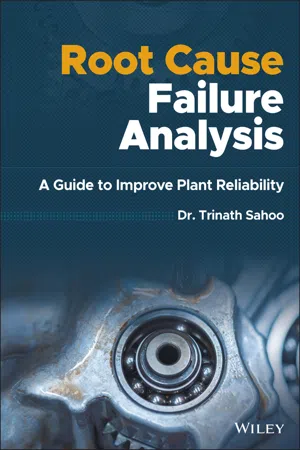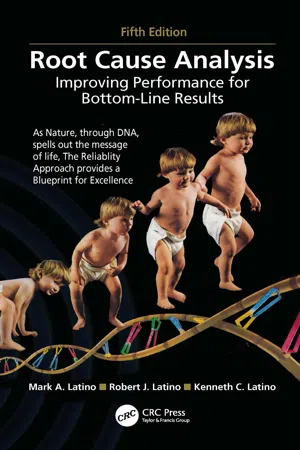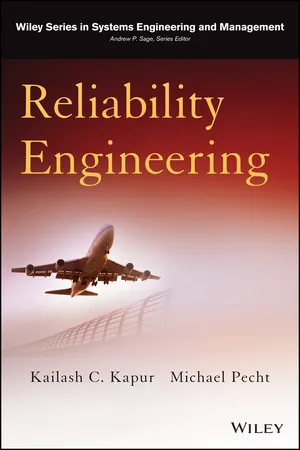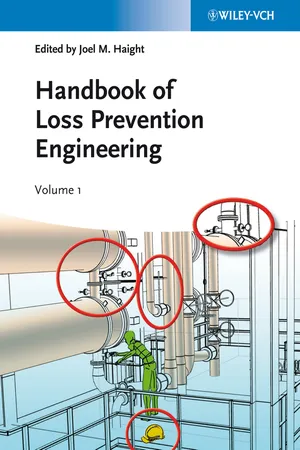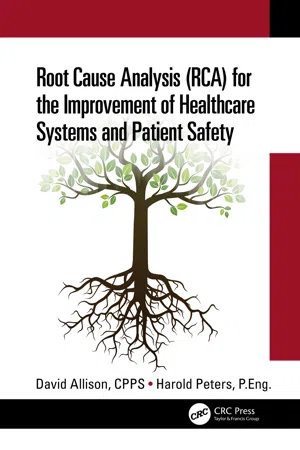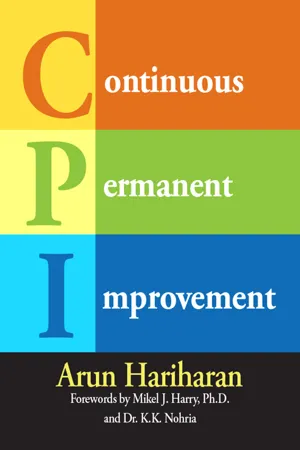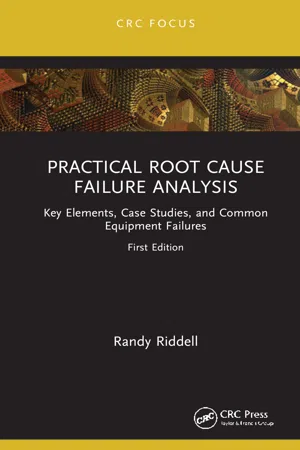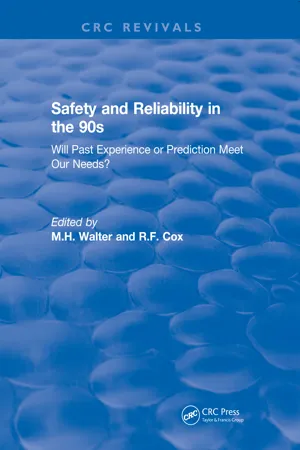Technology & Engineering
Root Cause Analysis
Root Cause Analysis is a systematic process used to identify the underlying causes of problems or issues within a system. It involves investigating the root cause of a problem rather than just addressing its symptoms. By understanding the fundamental reasons for an issue, organizations can implement more effective and sustainable solutions.
Written by Perlego with AI-assistance
Related key terms
Related key terms
1 of 4
Related key terms
1 of 3
11 Key excerpts on "Root Cause Analysis"
- Cheryl Tulkoff, Greg Caswell(Authors)
- 2021(Publication Date)
- Wiley(Publisher)
7 Root Cause Problem‐Solving, Failure Analysis, and Continual Improvement Techniques7.1 Introduction
Root Cause Analysis (RCA) encompasses a category of problem‐solving methods that focus on identifying the ultimate underlying reason of why an event occurred. Root Cause Analysis is a generic term for diligent structured problem‐solving. Over the years, various RCA techniques and management methods have been developed. All RCA activities are problem‐solving methods that focus on identifying the underlying reason of why an undesired issue occurred. RCA is based on the belief that problems are most effectively solved by correcting or eliminating the root causes rather than merely addressing the obvious symptoms. The root cause is the trigger point in a causal chain of events. This trigger point may be natural or manmade, active or passive, initiating or permitting, obvious or hidden. Efforts to prevent or mitigate the trigger event are expected to prevent the outcome or at least reduce the potential for problem recurrence.RCA is a comprehensive analysis method that identifies the chain of physical and human‐related root cause(s) behind an undesirable event. This differs from basic troubleshooting and problem‐solving processes that typically seek solutions to specific, relatively simple difficulties. The undesired event may be a product durability failure, a safety incident, a customer complaint, a quality defect, or a result of human error. RCA focuses the corrective and preventive action (CAPA) efforts on the actions that have the greatest potential impact. It is essential for guiding change management efforts in the most effective and cost‐efficient direction.The goal of RCA is preventing failures before they happen. Prevention can be accomplished via a thorough understanding and analysis of designs, materials, suppliers, and customers. When failures do occur, however, organizations also need methods that enable them to quickly learn from and respond to these events. Effective use of RCA enables the most economical use of resources to achieve these goals. RCA also drives the pursuit of actions most likely to result in success. All companies have constraints on people, money, and time. If an organization doesn't analyze, learn from, and prevent problems, it simply repeats them.- eBook - ePub
Root Cause Failure Analysis
A Guide to Improve Plant Reliability
- Trinath Sahoo(Author)
- 2021(Publication Date)
- Wiley(Publisher)
3 Root Cause Analysis ProcessThe key to a good Root Cause Analysis is truly understanding it. Root Cause Analysis (RCA) is an analysis process that helps you and your team find the root cause of an issue. RCA can be used to investigate and correct the root causes of repetitive incidents, major accidents, human errors, quality problems, equipment failures, production issues, manufacturing mistakes, and can even be used proactively to identify potential issues.The key to successful Root Cause Analysis is understanding a process or sequence that works. The effect is the event – what occurred. A cause is defined as a set of circumstances or conditions that allows or facilitates the existence of a condition an event. Therefore, the best strategy would be to determine why the event happened. Simply put, eliminating the cause or causes will eliminate the effect.What is Root Cause Analysis
Root Cause Analysis is a logical sequence of steps that leads the investigator through the process of isolating the facts or the contributing factor surrounding an event or failure. Once the problem has been fully defined, the analysis systematically determines the best course of action that will resolve the event and assure that it is not repeated. A contributing factor is a condition that influences the effect by increasing the probability of occurrence, hastening the effect, and increasing the seriousness of the consequences. But a contributing factor will not cause the event. For example, a lack of routine inspections prevents an operator from seeing a hydraulic line leak, which, undetected, led to a more serious failure in the hydraulic system. Lack of inspection didn’t cause the effect, but it certainly accelerated the impact. - eBook - ePub
CAPA in the Pharmaceutical and Biotech Industries
How to Implement an Effective Nine Step Program
- J Rodriguez(Author)
- 2015(Publication Date)
- Woodhead Publishing(Publisher)
9Step 6: part I—Root Cause Analysis
Abstract
Root Cause Analysis (RCA) is a systematic approach to get to the true root causes of our process problems. Without a systematic approach, or the lack of understating how to use the right RCA tool, problems will recur since the true root cause was not identified.RCA is useful in determining the cause(s) of variation so that the appropriate improvement action can be implemented and improvements can be sustained over time. Improvement action that is not focused on the root cause will not be effective, or at least not for very long, so to sustain the improvement over time, the in-depth causes must be found and fixed.The goal of this chapter is to identify a way of conducting an RCA to rationalize and standardize the application of this technique. The following pages are particularly focused on the identification of root causes for problems, so this is the mostly frequent used term, but the same procedure is valid for the identification of root causes for objectives. We will also look at several RCA tools, case studies, and examples of how to use such tools to effectively identify and define the specific factors that may be the causes of the problem. - eBook - ePub
Root Cause Analysis
Improving Performance for Bottom-Line Results, Fifth Edition
- Mark A. Latino, Robert J. Latino, Kenneth C. Latino(Authors)
- 2019(Publication Date)
- CRC Press(Publisher)
2Introduction to the Field of Root Cause Analysis
What Is Root Cause Analysis?
What a seemingly easy question to answer, yet no standard, generally accepted definition of Root Cause Analysis (RCA) exists in the industry today, of which we are aware. Technical societies, regulatory bodies, and corporations have their own definitions, but it is rare to find two definitions that match. For the sake of having an anchor or benchmark definition, we will use the definitions provided by the Department of Energy (DOE) Guideline entitled “Root Cause Analysis Guidance Document (DOE-NE-STD-1004-92).”1In the DOE document referenced above, the following is cited:The document goes to say that every root cause investigation and reporting process should include the following five phases:The basic reason for investigating and reporting the causes of occurrences is to enable the identification of corrective actions adequate to prevent recurrence and thereby protect the health and safety of the public, the workers and the environment.- Data collection
- Assessment
- Corrective actions
- Inform
- Follow-up.
When we look at any investigative occupation, these five steps are critical to the success of the investigation. As we progress through this text, we will align the steps of the PROACT® - eBook - ePub
- Kailash C. Kapur, Michael Pecht(Authors)
- 2014(Publication Date)
- Wiley(Publisher)
Consider testing of a printed circuit board (PCB) after fabrication. A symptom of failure upon testing is an open circuit. The apparent cause of the open circuit is that circuit traces on the PCB have discontinuities (scratches). The root cause for the failure could be that during the manufacturing process, the circuit boards are stacked improperly, resulting in scratches to circuit traces on the PCB.Root-cause analysis is a methodology designed to help describe what happened during a particular occurrence, determine how it happened, and understand why it happened (ABS Group, Inc. 1999). The purpose of determining the root cause is to fix the problem at its most basic source so that it does not occur again, even in other products, as opposed to troubleshooting, which is generally employed to merely fix a failure symptom in a given product.Example 16.2
Consider field removals of aircraft electronic equipment (avionics). Table 16.1 gives identified reasons for the field removals. The reasons are classified in broad categories, according to the life-cycle phase (e.g., design, manufacturing, and application) when the item was removed, or the type of damage (e.g., electrical, thermal-mechanical) incurred by the item. However, the actual root causes are not shown. Certain removals are “unjustified,” “unexplained,” “apparently” attributed to one type of causal reason, or “not verified,” indicating that the root-cause analysis effort has not been successful.Table 16.1 Assessment of field removals of aircraft electronic equipmentRemoval Assessment % From a Boeing studya Unjustified 30 Assembly errors, handling damage 60 Design, improper installation 9 Parts manufacturing problems 1 Unexplained <1 From a Rockwell studyb Not verified 36 Apparent electrical 22 Part application 15 Process problem 12 Bad lot 6 Design 6 Miscellaneous 2 Workmanship 1 From a Westinghouse reportc Retest OK 31 Electrically damaged 30 Thermal mechanical stress and switching 21 Manufacturing/quality/design defects 18 a Pecht, M., and Ramappan, V., “Review of Electronic System and Device Field Failure Returns,” IEEE Transactions on CHMT - eBook - ePub
- Joel M. Haight, Joel M. Haight(Authors)
- 2013(Publication Date)
- Wiley-VCH(Publisher)
Unfortunately, it is also very common to find organizations that fail to measure the effectiveness of that formal process which they are using with the intention of reducing future problems of a similar nature. For example, do you think that a human error or equipment failure is typically a root cause of a process failure? In reality it is a rare case that either human error or equipment failure is a root cause. However, if you examine the RCA results found in projects conducted by green belts and black belts – people who have been formally trained and certified to support a Six Sigma improvement effort (De Feo and Barnard, 2005) – you will find a high percentage of root causes of this exact nature!When selecting a formal RCA process for use, consideration should be given to the design of the RCA process itself. For example, is the process one where the team uses brainstorming to identify the potential root causes of a problem, and then uses multi-voting to select what they think are the key root causes to develop countermeasures for? If one has been trained to ask effectively “Why?” five times, they can obtain very meaningful results. If, however, one attempts to apply the “Five Why” concept (De Feo and Barnard, 2005) with very little training, the likelihood of a fix failing increases dramatically.Another key way to identify the potential for a given RCA process working or not is to examine the type of emphasis it places on human error and equipment failure. If the design of the RCA process allows for the definition of human error and equipment failure as root causes, it is possible that there are also other design flaws in this process. Attempting to write an effective corrective action which minimizes the potential for huge future human error first requires a definition of the systemic reasons that enhanced the potential for such errors.In a similar sense, when we conduct audits, we typically attempt to write corrective actions based on the unsafe act or non-compliant condition which was observed. Going straight “from human error to fix” will result in a very low probability of corrective action effectiveness and sustainability. Poorly defined root causes lead to ineffective countermeasures and wasted time, even when they are being defined to address proactive areas of process non-conformance. - David Allison, CPPS, Harold Peters, P.Eng.(Authors)
- 2021(Publication Date)
- CRC Press(Publisher)
24. M. Harmer, Independent Review on the Care Given to Mrs. Elaine Bromiley on March 29, 2005.Passage contains an image
2 Forms of Analysis
Having addressed the question of “Why?” to devote the time and resources to analyzing unintended events, we turn to the question of “How?” RCA is one tool for analysis, problem-solving, and improvement work. There are many others. And, unfortunately, RCA is not well defined in healthcare. The term can be used without specific regard for the precise definition of Root Cause Analysis, as opposed to other forms of analysis. It is, therefore, incumbent on those vested with facilitating RCAs to help assure it is appropriately applied.While this is a book focused on and advocating for RCA, it is important to note that there is a risk of over-using or misapplying the tool. Let us look at some of the options and consider the varying contexts in which analysis is needed. We will then address the question of how to decide which form of analysis to use.2.1 Troubleshooting
Troubleshooting may be needed and useful at the time an unintended event occurs. As an analytical tool, troubleshooting is utilized in real time or close to real time. In the case of one event, an error in the selection of medication used to perform a nerve block in surgery resulted in extravasation injury of the tissue. The impact of the error was discovered after the procedure was completed and the patient was in the post-anesthesia unit. The post-anesthesia nurse caring for the patient observed the deteriorating tissue and notified the patient’s anesthesiologist. Quickly the anesthesiologist, a partner, and the surgeon, came together to brainstorm what might have caused the problem. In troubleshooting this case, they were searching not only for the cause but also how to rapidly reverse the situation and prevent further harm.This type of troubleshooting is like what is seen in manufacturing when a machine goes down. In the manufacturing setting, the operator brainstorms possible causes with a focus on returning the machine to use as quickly as possible. This type of troubleshooting is done by individuals or teams, most frequently near the time and location an unintended event occurs.- eBook - ePub
- Arun Hariharan(Author)
- 2014(Publication Date)
- ASQ Quality Press(Publisher)
no.” RCA—THE EPITOME OF LEANThe beauty of Root Cause Analysis lies in its simplicity. As a former Toyota executive said with some sarcasm, “We have a very sophisticated technique. It is called five why. We ask why five times” (Likert 2004).One could say that RCA is the epitome of Lean. What other technique is so simple to understand, yet so big on results? No continuous improvement is possible without RCA. Doubtless, there are certain requirements to obtain real, substantial, and sustained results from RCA. These have been dealt with in detail in this chapter, and clearly, they mostly have to do with discipline and the right mind-set. For organizations (or individuals) that have this discipline and mind-set, defects and complaints become opportunities that propel them forward on the journey toward excellence!CAN PROBLEMS BE PREVENTED BEFORE THEY EVER OCCUR?So far in this chapter, we have talked about how to use a defect or problem, after it occurs at least once, to get to the root cause and prevent the problem from happening again. In a few of the companies that I worked with, somebody would ask, “But do we always have to wait for a problem to happen, and then prevent it? Can’t we anticipate what could go wrong and prevent it even before it happens?” A very useful question, and our experience on this is as follows.These companies used a simple practice of calling people involved in the process into a meeting and trying to identify everything that could go wrong. In other words, what were the risks or “failure modes” in the current process—for the customer or for regulatory compliance? In addition to identifying potential failure modes, answers to the following questions would also be discussed: Is there a way to do this process at a lower cost? Is there a way we could do this more efficiently? Often, some opportunities for improving the process would be identified this way. We used a simple two-way matrix (see Figure 21 ) to prioritize what improvements or process changes should be done immediately. Top priority was given to changes that would bring higher benefits, or carried - eBook - ePub
Practical Root Cause Failure Analysis
Key Elements, Case Studies, and Common Equipment Failures
- Randy Riddell(Author)
- 2022(Publication Date)
- CRC Press(Publisher)
1 Introduction to Successful Root Cause Failure Analysis (RCFA)DOI: 10.1201/9781003248675-1Root Cause Failure Analysis (RCFA) is a reliability process used to determine the causes of failure of a piece of equipment, component, system or even process. The goal of RCFA is to find these root causes so that some action can be taken to eliminate reoccurrence or more feasible to reduce the probability of reoccurrence. This goal is the focus of this book to evaluate what are the key elements of successful RCFA not only by looking at general concepts but specific examples on real-world industrial failures.I suspect that learning from failure has been something that humanity has studied since the fall in the Garden. The methodologies have certainly changed over time but the search for making things better has always been out in front of humanity.I am reminded of a story about a young man who was being mentored by a seasoned businessman. The young man asked what was the key to his success? The businessman said, “Two words, good decisions.” The young man continued to probe and asked, “well, how do I do that?” He answered, “One word, experience.” The young man thought, I can’t stop here so he asked, “Well how do I get that?” The businessman answered again, “Two words – bad decisions.” RCFA turns into success when we learn from not only our bad decisions but the bad decisions of everyone else as well.It probably needs to be said at this point that RCFA has several obstacles that keep us from wanting to learn from failure. For many the focus is on troubleshooting and not RCFA (more on that later). For some, firefighting is fun, and firefighting is rewarded by many organizations more than any proactive tasks. Probably the biggest hurdle in learning from failure is to refrain (avoid) from blaming others. RCFA should not involve blaming individuals or groups. Solutions will involve these two areas. While error is part of the human factor, it is common among all of us. It has been said, “to err is human and to blame someone else, well that shows management potential.” - eBook - ePub
Patient Safety
Investigating and Reporting Serious Clinical Incidents
- Russell Kelsey(Author)
- 2016(Publication Date)
- CRC Press(Publisher)
2 Root Cause Analysis: Background and contextTwo phenomena intersected in the 1950s and 1960s that were to have a profound influence upon patient safety in the healthcare sector – the emergence of the Japanese motor industry and the massive expansion of the aviation industry. It is within these two industries that the concept of Root Cause Analysis as a means of identifying and solving problems arose.The origin of Root Cause Analysis is important. It explains both why it is so potentially useful but also why it often fails to work well in healthcare. It is salutary for clinicians and service managers to realise that while the processes and techniques we use to manage clinical encounters are vested in many years of professional clinical experience and scientific development, most of the processes and techniques that are used to manage the logistics and in particular the governance of healthcare have been adopted from other industries.Sakichi Toyada, the founder of Toyota Motor Corporation, is credited with developing formal techniques for improving production quality, including the ‘5 Whys’ technique that was used to analyse production failings to find the ultimate root cause of failure. Researchers in the emerging Japanese industrial giants, including Kaoru Ishikawa working for the Kawasaki company – famous for his ‘fishbone’ diagram – developed the concept of total quality management (TQM). Arising from these concepts and processes come other industrial quality-improvement processes increasingly familiar in healthcare such as Six Sigma and lean management. At the same time, in the United States the responsibility for investigating aviation safety was delegated to National Aeronautics and Space Administration (NASA) and scientists there started to develop formalised techniques for incident investigations. The results of the use of formalised investigation aimed at learning from identified errors was striking: - eBook - ePub
Revival: Safety and Reliability in the 90s (1990)
Will past experience or prediction meet our needs?
- M.H. Walter, R.F. Cox(Authors)
- 2019(Publication Date)
- Chapman and Hall/CRC(Publisher)
The identified changes between Normal and Actual Operation will, usually, lead the investigator to easily identify the Direct Causes of the accident. The Root Causes are identified from the changes which took place such that Normal Operation differed from Design Intent in the way described above. In practice, Root Causes are nearly always found to be occurrences which allowed the precursor conditions of the accident (i.e. the Direct Causes) to come into existence. The trigger event is essentially a chance occurrence, and in some cases may be a routine activity. The Root Causes therefore, are generally found to be deficiencies which allowed latent failures to occur and to be perpetuated over a period of time.APPLICATION OF Root Cause Analysis
The uses of Root Cause Analysis
Root Causes of accidents are, adopting the approach described above, associated with conditions or modes of operation with have come to be accepted as normal yet which differ in some way from the design or intended conditions. In many circumstances, this situation may well continue to exist for considerable periods of time without causing any noticeable abnormal effects. In fact, such situations almost certainly exist to some degree, undetected or uncorrected, in most organisations at some time. Where the activities of the organisation involve hazardous operations, then the situations where divergencies exist between design/intent and normal operation will contain within them the seeds of an accident waiting to happen. It is in these situations where the insights of Root Cause Analysis of previous accidents will be particularly valuable.The approach has been tested using, as case studies, the published reports of a number of recent accidents. Published case studies have been used for reasons of availability and the fact that the material is already in the public domain. Choosing, as case studies, accidents which have already been thoroughly investigated is not, however, the ideal method of testing the approach, i.e. the test is necessarily biased because the causes have already been established. Thus the opportunity is sought to use the approach for investigation of safety significant incidents where it is important to establish the root causes definitively in a systematic way. The objective of the approach in this situation, will not be to establish blame or for litigational purposes, but to reduce future risk levels by learning the lessons of the past.
Index pages curate the most relevant extracts from our library of academic textbooks. They’ve been created using an in-house natural language model (NLM), each adding context and meaning to key research topics.
Explore more topic indexes
Explore more topic indexes
1 of 6
Explore more topic indexes
1 of 4

